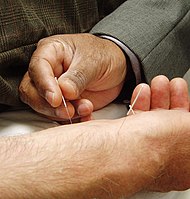
Photo from wikipedia
Invasive procedures performed in children, especially in the first year of life, carry a risk of significant vascular injury. Numerous cases of pseudoaneurysm secondary to vascular catheterization have been described… Click to show full abstract
Invasive procedures performed in children, especially in the first year of life, carry a risk of significant vascular injury. Numerous cases of pseudoaneurysm secondary to vascular catheterization have been described in the paediatric population. The mechanism of injury seems to be associated with the small size of the vessels and the movements performed in catheterization attempts, which may tear vessel walls. Failure to apply local compression after catheter insertion is also considered one of the frequent mechanisms of injury. Multiple therapeutic options have been suggested to treat post-traumatic pseudoaneurysms in paediatric patients, including ultrasound-guided compression, intralesional thrombin injection, endovascular treatment and surgical repair. The clinical history of all patients diagnosed and treated for posttraumatic pseudoaneurysm in our center between 2008 and 2021 was reviewed. (Table 1). We contacted the parents of the patients to collect information on their current quality of life, the need of follow-up and the presence of complications. Between 2008 and 2021, 6 patients received a diagnosis of post-traumatic pseudoaneurysm. Two were preterm infants who needed multiple vascular access lines during their prolonged stay in the neonatal unit. Five were aged less than 1 year at the time of diagnosis of the pseudoaneurysm, and 1 patient was aged 12 years. All patients had a history of traumatic vascular access prior to diagnosis of the pseudoaneurysm. Five had arterial pseudoaneurysms (3 in the left brachial artery and 2 in the right brachial artery), while 1 presented with pseudoaneurysm in the left cephalic vein.
Journal Title: Anales de pediatria
Year Published: 2022
Link to full text (if available)
Share on Social Media: Sign Up to like & get
recommendations!